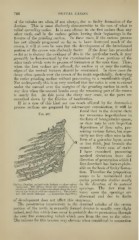Page 756 - My FlipBook
P. 756
766 DENTAL CARIES.
of the tubules are often, if not always, clue to faulty formation of the
dentine. This is most distinctly demonstrable in the case of what is
called spreading caries. It is seen oftener in the first molars than any
other teeth, and in the carious points having their beginnings in the
fissures of the grinding surface. In these cases, if the carious process
has not already progressed so far as to have destroyed much of the
crown, it will at once be seen that the development of the first-formed
portion of the crown was distinctly faulty. If tlie decay has proceeded
so far as to destroy the evidence of this in the particular tooth, it may
generally be demonstrated by the examination of those portions of the
other teeth which were in process of formation at the same time. Thus,
when the first molars are affected, the surface at or near the cutting
edges of the central incisors should be scrutinized. In these cases the
decay often spreads over the crown of the tooth superficially, destroying
the entire grinding surface without penetrating to a considerable depth.
Not unfrequently this is so very marked that the caries is seen to extend
under the enamel over the margins of the grinding surface in such a
way that when the enamel breaks away the remaining part of the crown
is nearly flat. At this point the decay may cease, as the parts are
smoothed down by the friction of mastication.
If in a case of this kind not too much affected by the destructive
process sections are prepared for microscopic examination, it will be
found that in the dentine there
Fjg. 402.
^j.g numerous imperfections in
the form of interglobular spaces,
or there may be very imperfect
depositions of lime salts, pre-
senting various forms, but espe-
cially are they often seen in the
form of a granular layer, more
or less thick, just beneath the
enamel. Every case of caries
I have examined presenting
marked deviations from the
direction of penetration which I
first described has been explain-
able on the basis of faulty forma-
tion. Therefore the proposition
seems to be maintained that
caries penetrates dentine mosth/
Carious Dentine, stained with fiidhsin to show micro- in the direction of its ncdurcd
orcanisnis. The section shows the condition of tlie The
tubules as filled with niicro-orRanisnis alone the junc- openings. fact that in
tion of the dentine with the enamel at n. The tubules many cases the openings are
are very much enlarged. (^'^ immersion objective.)
abnormal and due to faults
of development does not affect this statement.
The penetration transversely to the dentinal tubules of the crown
portion of the tooth in normally-formed dentine is usuallv verv slight
indeed, and that which does occur is probably due to penetration through
the very fine connecting tubuli which pass from the one to the other.
The reasons for this become very obvious when considered in connection


